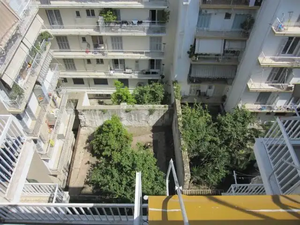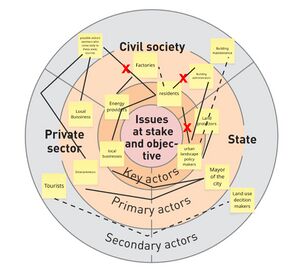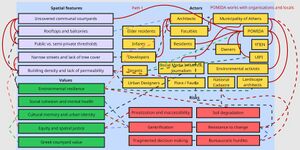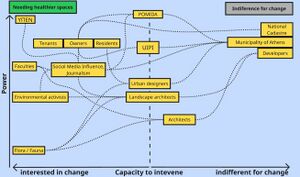Democratic Landscape Transformation 2025 - Team 2: Difference between revisions
| (13 intermediate revisions by the same user not shown) | |||
| Line 13: | Line 13: | ||
*Mariia Novoselova, Russia/Italy. I hold a Bachelor's degree in Reconstruction and restoration of architectural heritage from Saint Petersburg State University of Architecture and Civil Engineering (SPbGASU). Currently I am completing my Master's in Architecture and creative practices for the city and landscape from the University of Bologna. I have various work experiences in design, architecture, reconstruction and landscape. I am passionate about contemporary architecture, sustainable design and the psychological principles to create environments that enhance mental health and well-being. | *Mariia Novoselova, Russia/Italy. I hold a Bachelor's degree in Reconstruction and restoration of architectural heritage from Saint Petersburg State University of Architecture and Civil Engineering (SPbGASU). Currently I am completing my Master's in Architecture and creative practices for the city and landscape from the University of Bologna. I have various work experiences in design, architecture, reconstruction and landscape. I am passionate about contemporary architecture, sustainable design and the psychological principles to create environments that enhance mental health and well-being. | ||
*Fernanda Molina Gutiérrez, Mexiko/Germany | *Fernanda Molina Gutiérrez, Mexiko/Germany: I completed my Bachelor's degree in Architecture in Mexico City. Growing up in such a densely populated and urban environment, I became deeply aware of the lack of accessible green spaces. This realization led me to pursue a path in Landscape Architecture, with the goal of contributing to healthier, more livable cities places where people can reconnect with nature in their own hometowns. I see myself as an agent of change, especially now that the world is facing critical transformations. I find meaning in supporting others and being part of a nurturing, reciprocal network where we care for one another, just as we should care for nature. After all, the natural world sustains us; it’s only fair that we protect and nurture it in return. | ||
*Sheida Alaei Organi, Iran/Germany | *Sheida Alaei Organi, Iran/Germany | ||
*Tara Đukić, Serbia | *Tara Đukić, Serbia | ||
| Line 23: | Line 23: | ||
*Mariia Novoselova, [https://drive.google.com/file/d/1zd5zINuNECyeu-waLFRdAUKO6Rp8E71N/view?usp=sharing Right for a Landscape in the historical centre of Saint Petersburg] | *Mariia Novoselova, [https://drive.google.com/file/d/1zd5zINuNECyeu-waLFRdAUKO6Rp8E71N/view?usp=sharing Right for a Landscape in the historical centre of Saint Petersburg] | ||
*Fernanda Molina Gutiérrez, [ | *Fernanda Molina Gutiérrez, [https://drive.google.com/file/d/1PPhVfHz__YzALCeEW799LpanS9XkLnA7/view?usp=sharing Mexico City] | ||
*Sheida Alaei Organi, [http://xxxx/ add link] | *Sheida Alaei Organi, [http://xxxx/ add link] | ||
*Tara Đukić, [http://xxxx/ add link] | *Tara Đukić, [http://xxxx/ add link] | ||
| Line 37: | Line 37: | ||
*Mariia Novoselova,[Https://drive.google.com/file/d/1QAoQQ5fMdvW8IpPG8BI4KILAE0h4EG4j/view?usp=sharing Jane Jacobs] | *Mariia Novoselova,[Https://drive.google.com/file/d/1QAoQQ5fMdvW8IpPG8BI4KILAE0h4EG4j/view?usp=sharing Jane Jacobs] | ||
*Fernanda Molina Gutiérrez, [ | *Fernanda Molina Gutiérrez, [https://lowtechlab.org/en/the-low-tech-lab/presentation Quentin Matheus] | ||
*Sheida Alaei Organi, [http://xxxx add link] | *Sheida Alaei Organi, [http://xxxx add link] | ||
*Tara Đukić, [http://xxxx add link] | *Tara Đukić, [http://xxxx add link] | ||
| Line 46: | Line 46: | ||
* Due: May 21 | * Due: May 21 | ||
=== Context and Location === | === Context and Location === | ||
[[File:Akalyptos-640x480.webp|thumb|Greek courtyard|none]] | |||
''Courtyards have been a key feature of Greek architecture for centuries. Courtyard design and their relation to building density can affect the overall quality of life in urban areas, influencing daylight availability, thermal comfort, and the use of public and private spaces.'' | |||
=== Landscape and Community Map === | === Landscape and Community Map === | ||
[[File:Community analysis.jpg|thumb|none|Key actors]]We analysed the community of the area, how they interact with each other. | ''Present here a visual representation of the landscape and community context of the area. What are the main spatial features? Which actors can you identify and how are they related to the area? Which values exist and for whom? What is at risk and why? Try to generate creative/conceptual/synthetic representation''[[File:Community analysis.jpg|thumb|none|Key actors]]We analysed the community of the area, how they interact with each other. | ||
[[File:Community map - Greek courtyard.jpg|none|thumb|Community Map and Relations]] | [[File:Community map - Greek courtyard.jpg|none|thumb|Community Map and Relations]] | ||
| Line 60: | Line 62: | ||
Power maps characterise the capacity to intervene in the situation's regulation and improvements. In our case the most value is given to the POMIDA (Hellenic Property Federation is the national organisation of immovable private property and building owners of Greece). This organisation unites residents, helps them to communicate with the government and work to improve the private property conditions and relates issues. | Power maps characterise the capacity to intervene in the situation's regulation and improvements. In our case the most value is given to the POMIDA (Hellenic Property Federation is the national organisation of immovable private property and building owners of Greece). This organisation unites residents, helps them to communicate with the government and work to improve the private property conditions and relates issues. | ||
[[File:Power map Greece.jpg|none|thumb]] | [[File:Power map Greece.jpg|none|thumb|Power Map, capacity to intervene]] | ||
== Your Team's Landscape Democracy Vision and Ideas (Phase C) == | == Your Team's Landscape Democracy Vision and Ideas (Phase C) == | ||
Latest revision as of 16:45, 28 May 2025
>>> Back to working group overview
>>> Back to seminar reading list, session materials & recordings
>>> go to the Editing Help
Seminar process at a glance
Background of your team
Please present your team briefly. Which linguistic and cultural perspectives does each member bring in? Which disciplinary backgrounds are present in your team? Note: if you prefer to stay anonymous on this wiki, you can also use initials only or a nick name
- Mariia Novoselova, Russia/Italy. I hold a Bachelor's degree in Reconstruction and restoration of architectural heritage from Saint Petersburg State University of Architecture and Civil Engineering (SPbGASU). Currently I am completing my Master's in Architecture and creative practices for the city and landscape from the University of Bologna. I have various work experiences in design, architecture, reconstruction and landscape. I am passionate about contemporary architecture, sustainable design and the psychological principles to create environments that enhance mental health and well-being.
- Fernanda Molina Gutiérrez, Mexiko/Germany: I completed my Bachelor's degree in Architecture in Mexico City. Growing up in such a densely populated and urban environment, I became deeply aware of the lack of accessible green spaces. This realization led me to pursue a path in Landscape Architecture, with the goal of contributing to healthier, more livable cities places where people can reconnect with nature in their own hometowns. I see myself as an agent of change, especially now that the world is facing critical transformations. I find meaning in supporting others and being part of a nurturing, reciprocal network where we care for one another, just as we should care for nature. After all, the natural world sustains us; it’s only fair that we protect and nurture it in return.
- Sheida Alaei Organi, Iran/Germany
- Tara Đukić, Serbia
- Eirini Antypa, Greece
- Tamara Kálmán,
Your Landscape Democracy Manifestoes (Phase A)
Here you can add here the links to the manifestoes you have presented on April 23. Please make sure that the links are accessible. You can also add them directly here on the wiki, they need to be png or jpg format then.
- Mariia Novoselova, Right for a Landscape in the historical centre of Saint Petersburg
- Fernanda Molina Gutiérrez, Mexico City
- Sheida Alaei Organi, add link
- Tara Đukić, add link
- Eirini Antypa, add link
- Tamara Kálmán, add link
Entering the Process: Activism, Community and Power (Phase B)
Global Landscape Democracy Role Models and Design Activism
- Due: May 14
At the beginning of phase B we ask you to identify people who are already active for democratic landscape transformation. These can be planners and designers, NGOs, collectives or activists, or people operating creatively at the interface of these categories. 'Design activism' is a possible overarching category. We created a list some time ago, but it has a very US/European focus, due to the history of our project. We really want to expand this and hope you can bring in new people and movements from around the globe.
On May 14, every team member introduces a landscape democracy activist/or design activist individual or group. Please add the people you introduced, you may also add the presentation material used with a downloadable link:
- Mariia Novoselova,Jane Jacobs
- Fernanda Molina Gutiérrez, Quentin Matheus
- Sheida Alaei Organi, add link
- Tara Đukić, add link
- Eirini Antypa, add link
- Tamara Kálmán, add link
Your Team's Landscape Democracy Challenge (Phase B)
- Due: May 21
Context and Location
Courtyards have been a key feature of Greek architecture for centuries. Courtyard design and their relation to building density can affect the overall quality of life in urban areas, influencing daylight availability, thermal comfort, and the use of public and private spaces.
Landscape and Community Map
Present here a visual representation of the landscape and community context of the area. What are the main spatial features? Which actors can you identify and how are they related to the area? Which values exist and for whom? What is at risk and why? Try to generate creative/conceptual/synthetic representation
We analysed the community of the area, how they interact with each other.
Landscape and community maps represent relations between key features of the site, its values, actors involved in the issue, and possible risks. Also, there is an example of a path which can be undertaken to improve the situation. As well, links between different aspects are shown.
Power Map
Based on the landscape and community context depicted above: How is power distributed? Who and what has a lot of power? Who and what has no power? Who and what is strongly affected by the landscape democracy challenges? Who and what is less affected? Are these actors connected or disconnected? Any veto-players known? Try to generate creative/conceptual/synthetic representation
You can present your results in this gallery:
Power maps characterise the capacity to intervene in the situation's regulation and improvements. In our case the most value is given to the POMIDA (Hellenic Property Federation is the national organisation of immovable private property and building owners of Greece). This organisation unites residents, helps them to communicate with the government and work to improve the private property conditions and relates issues.
Your Team's Landscape Democracy Vision and Ideas (Phase C)
- Due: June 18
Collective Vision
If you were to redesign the power map of your area and start a process of democratic landscape transformation: Which long term-goal could keep the process going? What could be a collective vision that integrates the goals of your team? Give a name to your vision. Try to generate creative/conceptual/synthetic representation.
A prototype of the first step
How would you enter the process? Which prototype could activate it? How would you introduce the prototype to the community?
You can present your results in this gallery:
- Your vision 1.jpg
add caption here
- Your prototype example 1.jpg
add caption here
- Your prototype example 2.jpg
add caption here
Cross-cutting activity: Readings, concepts and definitions (Phases A - D)
- Due: July 2, 2025
While working in your group, please start to express your personal understanding of the relation of landscape and democracy in the form of a concept map with linking words or any other diagrammatic representation. Please make your maps very visual and not just verbal. Think critically about why one map differs from another.
The final product is a shared concept map that integrates the various understandings present within your team.
About concept mapping
Before starting the exercise you can read this article by Joseph D. Novak & Alberto J. Cañas about Theory Underlying Concept Maps and How to Construct and Use Them. This paper gives a good explanation of how concept maps are conceived and developed.
You can use any tool you like for producing your concept map. However, since the result needs to be submitted digitally we recommend the following open source software for producing your maps:
- Cmap Tools >>> you can also work with your group on the Cmap cloud doing a shared map
- VUE - The Visual Understanding Environment
- Use a shared whiteboard to develop your integrated concept map, such as MIRO or MURAL
How to present your concept maps
- Possible format: JPG (for wiki upload) or link to any other resource
- We give you below a draft image gallery where you can add pictures of your map (in JPG or PNG format)
- You can present your integrated understanding as one concept map or your present individual ones and the integrated one.
- add as many additional materials as you need
Overview of your concept maps (individiual and integrated)
- Yourfilename.jpg
- Yourfilename.jpg
- Yourfilename.jpg
- Yourfilename.jpg
Please finish with a short reflection (Phase D)
Due: July 9, 2025
- What are the similarities and differences in your team regarding your understanding of what democratic landscape transformation is?
- In how far did the seminar lectures and readings help you to clarify this?
- What will you take home from this seminar?




